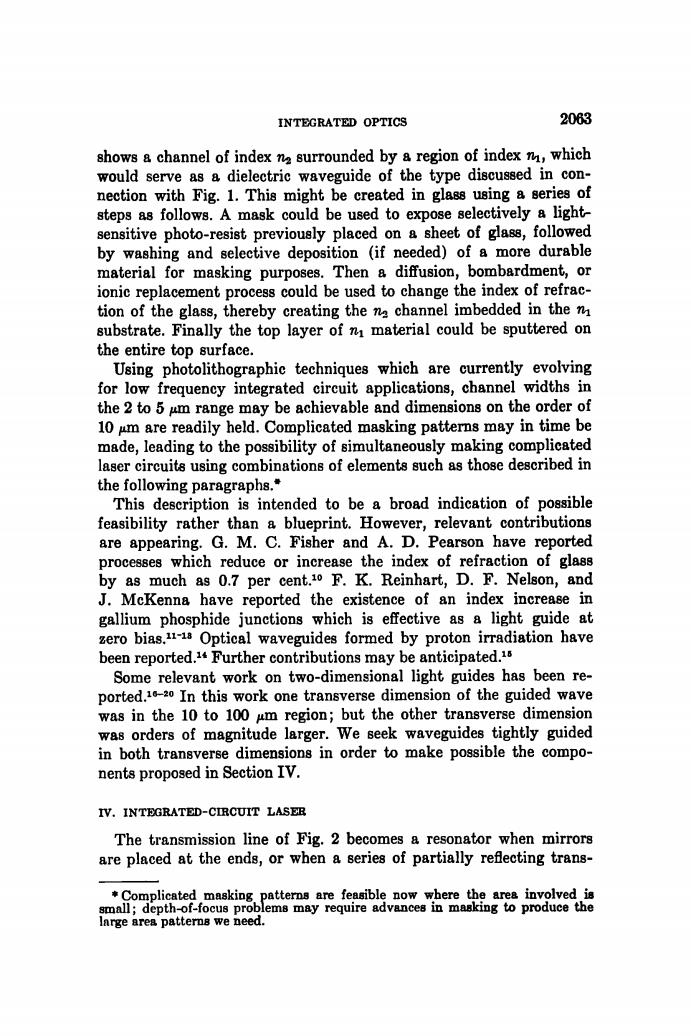正在加载图片...

INTEGRATED OPTICS 2063 shows a channel of index na surrounded by a region of index m,which would serve as a dielectric waveguide of the type discussed in con- nection with Fig.1.This might be created in glass using a series of steps as follows.A mask could be used to expose selectively a light- sensitive photo-resist previously placed on a sheet of glass,followed by washing and selective deposition (if needed)of a more durable material for masking purposes.Then a diffusion,bombardment,or ionic replacement process could be used to change the index of refrac- tion of the glass,thereby creating the na channel imbedded in the n substrate.Finally the top layer of n material could be sputtered on the entire top surface. Using photolithographic techniques which are currently evolving for low frequency integrated circuit applications,channel widths in the 2 to 5 um range may be achievable and dimensions on the order of 10 um are readily held.Complicated masking patterns may in time be made,leading to the possibility of simultaneously making complicated laser circuits using combinations of elements such as those described in the following paragraphs." This description is intended to be a broad indication of possible feasibility rather than a blueprint.However,relevant contributions are appearing.G.M.C.Fisher and A.D.Pearson have reported processes which reduce or increase the index of refraction of glass by as much as 0.7 per cent.10 F.K.Reinhart,D.F.Nelson,and J.McKenna have reported the existence of an index increase in gallium phosphide junctions which is effective as a light guide at zero bias.11-18 Optical waveguides formed by proton irradiation have been reported.Further contributions may be anticipated. Some relevant work on two-dimensional light guides has been re- ported.10-20 In this work one transverse dimension of the guided wave was in the 10 to 100 gm region;but the other transverse dimension was orders of magnitude larger.We seek waveguides tightly guided in both transverse dimensions in order to make possible the compo- nents proposed in Section IV. IV.INTEGRATED-CIRCUIT LASER The transmission line of Fig.2 becomes a resonator when mirrors are placed at the ends,or when a series of partially refecting trans- Complicated masking patterns are feasible now where the area involved is small;depth-of-focus problems may require advances in masking to produce the large area patterns we need.INTEGRATED OPTICS 2063 * Complicated masking patterns are feasible now where the area involved is small; depth-of-focus problems ma y require advance s in masking t o produce the large area patterns we need. shows a channel of index surrounded by a region of index iht which would serve as a dielectric waveguide of the type discussed in connection with Fig. 1. This might be created in glass using a series of steps as follows. A mask could be used to expose selectively a lightsensitive photo-resist previously placed on a sheet of glass, followed by washing and selective deposition (if needed) of a more durable material for masking purposes. Then a diffusion, bombardment, or ionic replacement process could be used to change the index of refraction of the glass, thereby creating the channel imbedded in the rh substrate. Finally the top layer of τΐχ material could be sputtered on the entire top surface. Using photolithographic techniques which are currently evolving for low frequency integrated circuit applications, channel widths in the 2 to 5 /tm range may be achievable and dimensions on the order of 10 μΐη are readily held. Complicated masking patterns may in time be made, leading to the possibility of simultaneously making complicated laser circuits using combinations of elements such as those described in the following paragraphs.* This description is intended to be a broad indication of possible feasibility rather than a blueprint. However, relevant contributions are appearing. G. M. C. Fisher and A. D . Pearson have reported processes which reduce or increase the index of refraction of glass by as much as 0.7 per cent.*" F . K. Reinhart, D . F . Nelson, and J. McKenna have reported the existence of an index increase in gallium phosphide junctions which is effective as a light guide at zero bias.**'*' Optical waveguides formed by proton irradiation have been reported.** Furthe r contributions ma y be anticipated.*' Some relevant work on two-dimensional light guides has been reported.*"-'"' In this work one transverse dimension of the guided wave was in the 10 to 100 μχη region; but the other transverse dimension was orders of magnitude larger. We seek waveguides tightly guided in both transverse dimensions in order to make possible the components proposed in Section IV. IV. INTBGRATED-CIBCUIT LASER The transmission line of Fig. 2 becomes a resonator when mirrors are placed a t the ends, or when a series of partially reflecting trans-